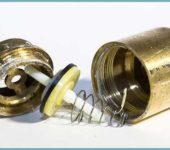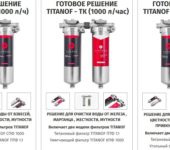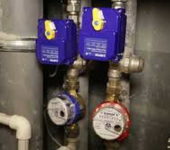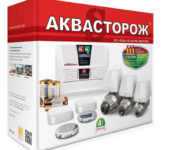How to choose a well pump
A well is often used to supply water to a house or water a plot. If earlier they could manage with a collar and a bucket even in a private house, but today, even in the country, this option no longer suits. After all, you can get modern conveniences by installing a pump for a well. For the system to work properly, you need to choose the right equipment. There is nothing super complicated in this, but you need to know a few things.
The content of the article
Types of pumps and their use for wells
According to the method of installation, the pumps are surface and submersible, according to the principle of operation - centrifugal and vibration. Both submersible and surface models are of both types. So in general, there are four kinds of equipment. To choose the right pump for a well, you need to understand the strengths and weaknesses of each type of this equipment.
Surface
The surface pump is attractive for its ease of installation and portability. The equipment itself is on the surface, and only the hose is lowered into the well. Another point is the low cost, which is explained by the fact that there is no need to make the case tight.

Surface well pump is very easy to connect
Despite all the advantages, surface models can be used for a shallow well. The maximum depth is 8 meters, but preferably less. This is the main limitation and their main disadvantage. The second negative point is low efficiency - no more than 25%. This is the lowest rate among all pumps.
Why not make more powerful equipment of this type? Because due to the peculiarities of the working cycle, the liquid that is lifted from a great depth is saturated with air bubbles (a phenomenon called cavitation). If water with a large amount of air bubbles gets into the working element, it will burn out.
You can get around the problem by using an ejector, which is built into the pipeline, which is lowered into the well. The depth from which surface installations with an ejector can pump water is much greater - up to 15 meters, but the efficiency is even less - around 15%, which means that electricity bills will be high.
Submersible
Submersible pumps for a well, at best, have an efficiency of about 45%, on average about 35%. From the name it is clear that they are located in the water column. This is the main difficulty - it must be well fixed, and then through the wall of the well, bring the highway into the house.
A submersible pump for a well is usually attached with a chain or a strong cable (ideally made of stainless steel). They are hooked to a special lug in the upper part of the body, the free end is wound on a collar, such as the one that used to raise buckets. With the help of this device, if necessary, raise the equipment to the surface.
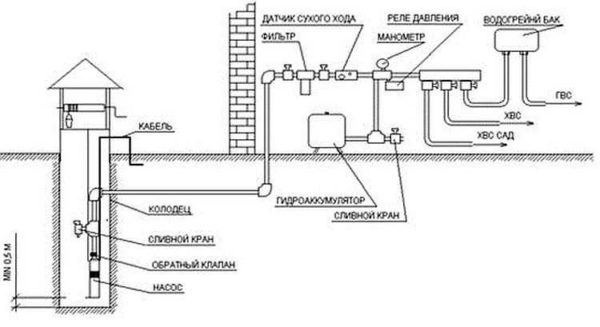
Method for installing a submersible pump in a well
Read more about water supply from a well (with diagrams and a description of the installation) here.
It is equally important to choose the position of the submersible pump in the well. It is necessary to make sure that at least a meter remains to the bottom (otherwise sand and silt may fall). At the same time, it is necessary that there is a sufficient layer of water above the body (it is necessary to look at the instructions, different models have different requirements). If the height of the water column in the well is small, this can be a problem. Although, there are models that allow horizontal installation in a well (For example, Aquario ASP).
| Name | A type | Pressure | Performance | Power | Manufacturer | Price | Notes |
|---|---|---|---|---|---|---|---|
| Grundfos SB 3-35 M | centrifugal, submersible | 33 m | 6.6 m3 / h | 800 watts | Italy | 250$ | overheat protection |
| Grundfos SB 3-35 AW | centrifugal, submersible | 33 m | 6.6 m3 / h | 800 watts | Italy | 330$ | Float switch |
| Grundfos SB 3-45 A | centrifugal, submersible | 43 m | 6.4 m3 / h | 1000 watts | Italy | 280$ | Float switch + overheating protection |
| Kid 10m / 16m / 25m / 40m | vibrating, submersible | 40 m | 0.43 m3 / h | 250 watts | Livny | $ 24 - $ 34 (depending on the length of the cord) | Lower water intake, diameter not less than 100 mm |
| Malysh-M-L 10 m / 16 m / 25 m / 40 m | vibrating, submersible | 40 m | 0.95 m3 / h | 240 watts | Livny | 23$ - 33$ | Upper water intake |
| Kid-K 10 m / 16 m / 25 m / 40 m | vibrating, submersible | 40 m | 0.95 m3 / h | 240 watts | Livny | 25$ - 34$ | Lower water intake + thermal protection |
| Kid-3 10 m / 16 m / 25 m / 40 m | vibrating, submersible | 40 m | 0.43 m3 / h | 160 watts | Livny | 25$ - 34$ | Bottom water intake, diameter not less than 76 mm |
| Dzhileks VODOMET PROF 40/50 A | centrifugal, submersible | 50 m | 2.4 m3 / h | 520 Wt | Russia | 160$ | Float + presence of solid particles 2 kg / m3 |
| Dzhileks VODOMET PROF 40/75 A | centrifugal, submersible | 75 m | 2.4 m3 / h | 670 Wt | Russia | 205$ | Float + presence of solid particles 2 kg / m3 |
| Dzhileks VODOMET PROF 55/35 A | centrifugal, submersible | 35 m | 3.3 m3 / h | 460 Wt | Russia | 135$ | Float + presence of solid particles 2 kg / m3 |
| Dzhileks VODOMET 55/35 М | centrifugal, submersible | 35 m | 3.3 m3 / h | 460 Wt | Russia | 135$ | Presence of solid particles 2 kg / m3 |
| Aquarius BTsPE 0,32-25 U up to 140 U | centrifugal, submersible | from 25 m to 140 m | 1.2 m3 / h | 440 W to 2500 W | Promelectro | 132$ - 290$ | overheat protection |
| Aquarius BTsPE 0.5 (from 16 U to 100 U) | centrifugal, submersible | from 16 m to 100 m | 1.8 m3 / h | 400 W to 2050 W | Promelectro | 115$ - 255$ | overheat protection |
| Aquarius BTsPE 1,2 (from 12 U to 80 U) | centrifugal, submersible | from 12 m to 80 m | 4.3 m3 / h | from 500 W to 2820 W | Promelectro | 140$ - 280$ | overheat protection |
| Aquarius BTsPEU 0.5 (from 16 U to 63 U) | centrifugal, submersible | from 16 m to 63 m | 1.8 m3 / h | 400 W to 1270 W | Promelectro | 125$ - 220$ | Overheating protection, smaller diameter |
Some explanations for the table. There are many more models with different characteristics than are presented in the table. Here are just a few, so that you can see the approximate range of prices and characteristics. In the description of pumps for wells Aquarius, there is an index of models in brackets, indicating the lift height with equal performance. The pumps "Malysh" have the length of the cord in the index, all other things being equal.
Vibrating
In a vibration pump for a well, water is pumped using a diaphragm or piston. They alternately create a vacuum, due to which water is sucked in, then build up pressure, pushing it into the outlet pipe. Such a working cycle creates a rather tangible vibration, which is why such devices are called vibration. Vibrating pumps can be of external or submersible type. Submersible vibrators are quieter - water dampens noise, outdoor ones - noisy devices.
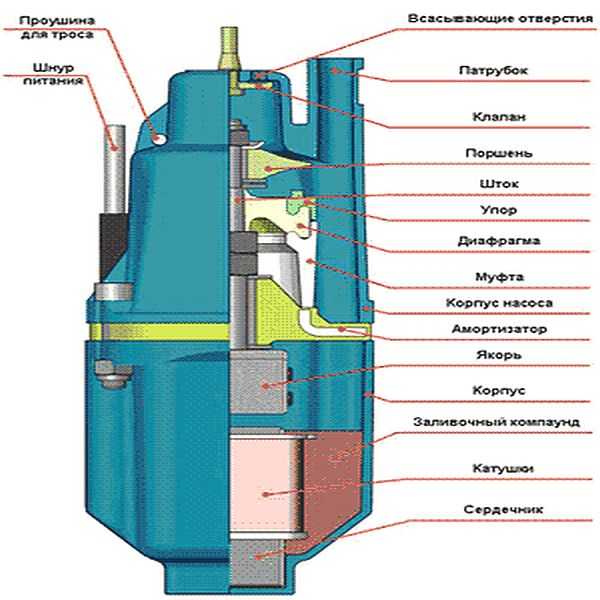
Vibration pump structure
The vibrator is a simple, inexpensive device, small in size and light in weight, thanks to which it is very mobile (weight - several kilograms) and can be used to pump small volumes - even lower it into a barrel, just do not forget to turn it off in time. All this is true, but there are many disadvantages:
- Vibration negatively affects the durability, the service life is short.
- Demanding power supply quality. When the voltage drops to 160 V, the performance drops by 2 times, with an increase, the power increases, but not so critical. Frequent drops lead to accelerated wear, so in a pair with a vibration pump for a well, buy a stabilizer, the simplest one, on a relay.
- Poorly tolerates the presence of sand and other debris in the pumped water. The design is such that you cannot put filters at the inlet, and the presence of abrasive particles (grains of sand) quickly renders the piston or diaphragm unusable. Therefore, such filters cannot be used on sandy soils.
This is the official data. And unofficial ones, according to operating experience, say that such pumps have to be changed often - they quickly burn out. So this type is good as a temporary solution - for occasional use in the country. For a guaranteed water supply to a home with permanent residence, it is better to take centrifugal models.
| Name | A type | Suction depth | Lift height (head) | Performance | Power | Price |
|---|---|---|---|---|---|---|
| DIOLD NP-0.4 | Surface vibration | 8 m | 32 m | 2100 l / h | 400 watts | 50$ |
| DIOLD NPV-800 | Surface vibration | 8 m | 60 m | 3000 l / h | 800 watts | 52$ |
| METABO HWA 3500 INOX | Surface vibration | 8 m | 45 m | 3500 l / h | 1100 Wt | 170 $ (protection against dry running and overheating) |
| METABO HWAI 4500 INOX | Surface vibration | 8 m | 48 m | 4500 l / h | 1300 Wt | 170 $ (protection against dry running and overheating) |
| PATRIOT R 900 | Surface garden | 8 m | 40 m | 3800 l / h | 850 Wt | $ 75 (float, nerdaveyka body) |
| VORTEX PN-370 | Surface centrifugal | 9 m | 30 m | 2700 l / h | 370 Wt | $ 40 (cast iron body) |
| VORTEX MON-1100CH | Surface centrifugal | 9 m | 50 m | 4200 l / h | 1100 Wt | $ 95 (cast iron body) |
| JUMBO 60/35 P | Surface centrifugal | 9 m | 35 m | 3600 l / h | 600 watts | $ 85 (polypropylene body) |
| JUMBO 60/35 h | Surface centrifugal | 9 m | 35 m | 3600 l / h | 600 watts | $ 95 (cast iron body) |
| JUMBO 70/50 H | Surface centrifugal | 9 m | 50 m | 4200 l / h | 1100 Wt | $ 120 (cast iron body) |
| AL-KO Jet 3000 Inox | Surface centrifugal | 8 m | 35 m | 3100 l / h | 650 Wt | $ 100 (stainless steel case) |
Centrifugal
In these units, water is pumped due to the movement of impeller-blades mounted on the central shaft. They are located in the pump working chamber. This chamber is filled with water. When the blades rotate, a reduced pressure is created in the center, and increased pressure at the edges. This difference makes the water move.
It is a centrifugal pump for a well that is bought more often. It is less sensitive to the presence of sand in the water, it has more working depths. On the negative side - a higher price, but the service life is much longer.
With or without a hydraulic accumulator
When organizing water supply from a well, many water from the pump is pumped into a hydraulic accumulator (storage tank), and from there it is already supplied to the points of water intake - taps, equipment. They put such a drive in the attic. It is needed to solve two problems at once:
- Extend pump life. If the water supply system is built without a hydraulic accumulator, the pump turns on every time a tap is opened in the house, household appliances that need water are triggered. Often such inclusions are only for a second or two, and each start is a minus to the service life. If there is a storage tank, then a small consumption comes from it. The water level is controlled by a float mechanism. It turns on the pump only after the water level in the tank reaches a critical level (set during installation).
- Increase the service life of the entire water supply system, including household appliances connected to it. The fact is that every turn on of the pump is a water hammer. Since the number of switching-ons per day amounts to hundreds, the service life of the equipment in the system is significantly reduced. In the presence of a hydraulic accumulator, all hydraulic shocks from the internal wiring and household appliances are cut off - they are extinguished by the water column in the accumulator.
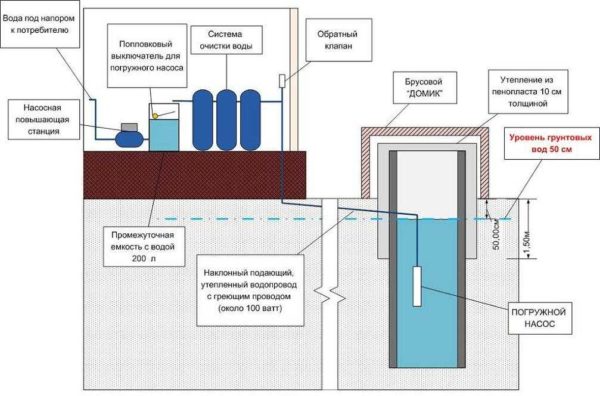
Water supply scheme of a house from a well with a pump and a hydraulic accumulator
So the storage tank in the water supply is a useful thing. How big should the accumulator be? Depends on the consumption (how to count it will be discussed below), they are put on both 25 liters and 150 liters, but the larger the stock, the better - less often the pump will turn on. As an additional bonus of installing a storage tank - some supply of water in case of a power outage.
Read how to purify water from a well here.
Selection by technical characteristics
Determining what type of pump you will install for a well is the lesser part of the task. Then you need to choose a manufacturer, and then find a suitable model that can supply water in the right amount with the required pressure. These are two main characteristics when choosing a pump for a well - capacity and head.
Performance (consumption)
The required pump capacity for a well (usually denoted by Q, measured in l / s or l / h, less often in cubic meters / h) is calculated based on the composition of the system. It has a certain number of taps, a toilet, a bidet, household appliances with a water flow. The water consumption for all these consumers is calculated (usually in liters per second). The flow rate can be taken on average 0.2 l / s for each point, but can be found in the table.
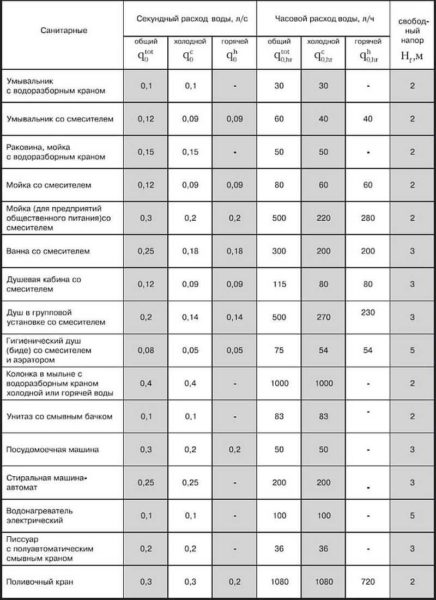
Water consumption for various plumbing fixtures
There is no need to add “just in case” to this figure.The calculation already contains more than a double margin: situations when all consumption points are turned on at the same time are practically excluded. At most, half of the consumers can work at the same time, and even then for a few seconds, but in reality even fewer points are turned on at the same time. So the stock is really big, and there is no need to increase it.
Pressure
The pump head (denoted by the letter H, measured in meters) is the amount by which it can raise water. When choosing a pump for a well, you need to know:
- The depth from which the water will rise (well depth).
- Ascent to the highest point of consumption. If there is a hydroaccumulator, this is its height, if not, this is usually the highest shower in the house.
- The total lifting height (Hgeo) is calculated as the sum of the depth of the well and the level at which the highest draw-off point is.
- The distance to which water must be transferred (L) horizontally, including the height of the rise to the highest point.
The formula for an accurate calculation is complex, so when selecting a pump for a well, they usually use a simplified version. One of them is in the photo.
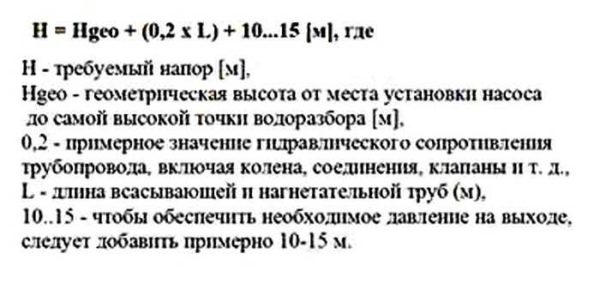
The formula for calculating the pump head
According to the found figure, the pump head for the well is selected.
Model selection by graphic characteristics
After you have decided on the pressure and performance, you need to choose a model. This is done according to the graphs showing the technical characteristics (in the photo below).
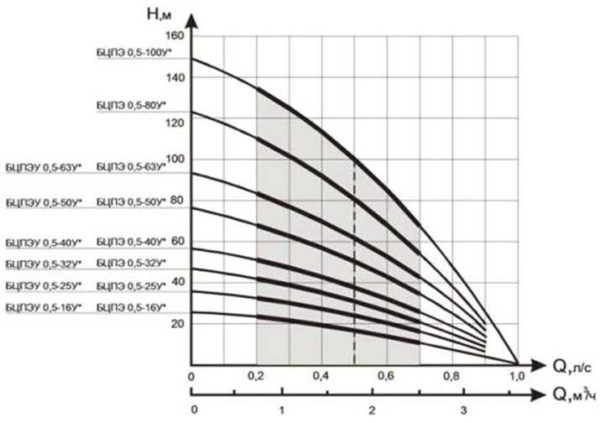
Example of graphical characteristics of pumps
There are similar charts in the technical specifications. You find on the coordinate axes the values that you previously calculated, find the point of their intersection on the plane. It should be located in the middle part of the graph (in the figure, this field is colored gray), then the pump will operate in normal mode, which guarantees its long service life. What if the point is outside the required area? Look for another model, this one is not suitable for your case.
The point was found, it fell into the middle of the performance characteristics. Then the graph closest to the point is your pump model (they are signed). What if several models are suitable at the same time? This happens if the point is located approximately in the middle between the charts. Take the one whose characteristics are above the point.
How to make a house for a well is described here (with step-by-step photos).
What to look for when choosing a pump for a well
In addition to the technical parameters and pump type, you will need to pay attention to a number of additional parameters:
- Idling protection is highly desirable. This is a situation where the pump is running but there is no water. Such moments often lead to breakdowns, sometimes the pressure simply deteriorates, air is "sucked in", etc. In this case, it is necessary to take the pump to a service center, perhaps it can be reanimated.
- Availability or possibility of additional equipment with a float sensor (it is also called a "frog"). It is a small sealed bulb attached to the body with a piece of cable. The sensor floats in water. When it drops below a certain mark, the pump turns off. It will turn on after the sensor rises up (if the taps are still open). This, by the way, is another plus of the circuit with a hydraulic accumulator - when the pump protection is triggered, you do not have to wait for it to turn on, you will use the water that is in the tank. You won't even notice the pump shutdown.
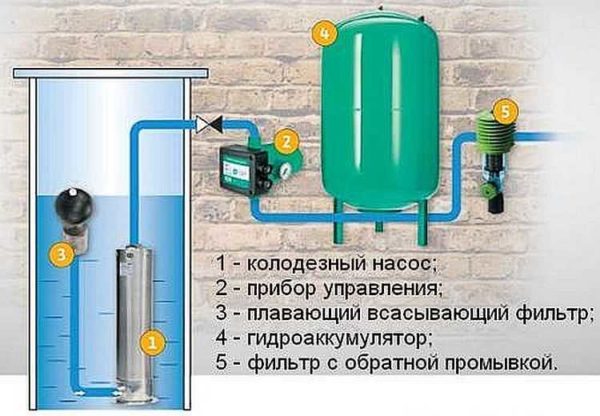
One of the variants of the system with a submersible pump for a well
- Overheating protection. The well pump may overheat during continuous continuous operation. To prevent this from happening, and do this protection.
- Pay attention to the build quality and fit of all body parts. No backlashes, surface defects (cavities, burrs, etc.), no mismatch of parts in size. These are all signs of poor quality.
- The length of the supply cable (sometimes up to 40 meters).This parameter may also be important - not all have electricity connected to the well.
- Temperature conditions. If you choose a pump for a well to give a seasonal visit, there is not much difference (if it is stored in a warm room). If the equipment will work all year round, it is necessary to choose models that can work in conditions of a small positive temperature.
The choice of a pump for a well can be considered complete. It is not an easy matter, but all these points must be tracked. Then the equipment will work for a long time and without problems.

